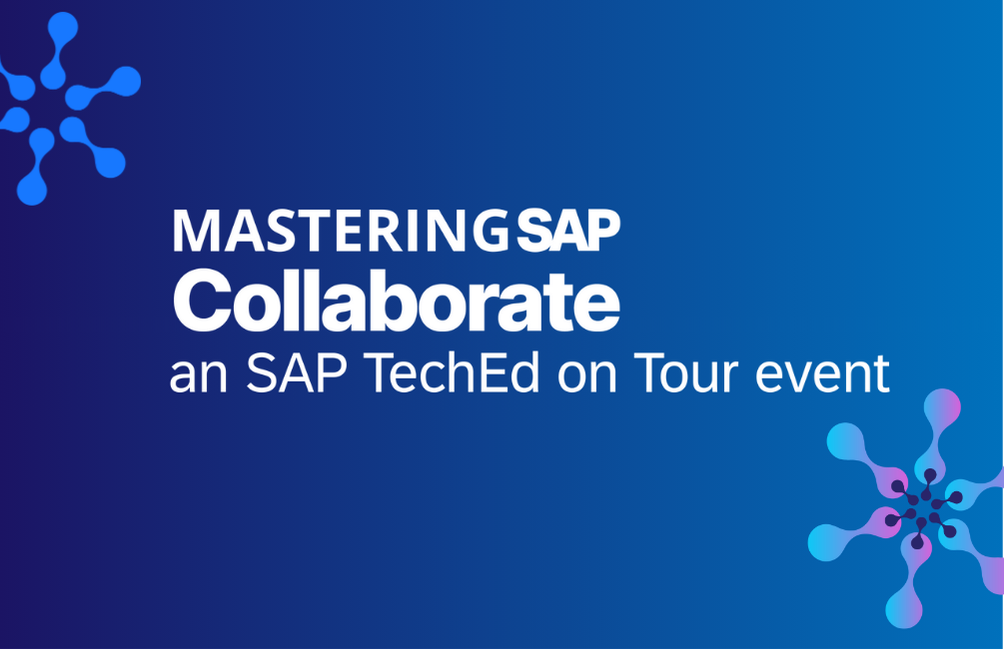SAP EWM
Filter By
Browse By
- SAP Analytics and AI
- SAP Application Development and Integration
- All SAP Application Development and Integration
- SAP ABAP
- SAP ABAP Development Tools
- SAP ABAP Test Cockpit
- SAP API Management
- SAP BAPI
- SAP Basis
- SAP BRF
- SAP Business Application Studio
- SAP CMS
- SAP Design Studio
- SAP Development Tools
- SAP DevOps
- SAP EAI
- SAP EDI
- SAP Extension Suite
- SAP Fiori
- SAP Fiori Elements
- SAP Integration Suite
- SAP Low Code Application Development
- SAP Low Code Automation
- SAP Netweaver
- SAP Release Management
- SAP UI5
- SAP Web Application Server
- SAP Web IDE
- SAP Business Process Management
- SAP Center of Excellence
- SAP CIO
- SAP Customer Experience
- SAP Data and Data Management
- All SAP Data and Data Management
- SAP BW
- SAP BW/4HANA
- SAP Crystal Reporting
- SAP Data Archiving
- SAP Data Center
- SAP Data Governance
- SAP Data Integration
- SAP Data Migration
- SAP Data Quality
- SAP Data Services
- SAP Data Strategy
- SAP Data Visualization
- SAP Data Warehouse Cloud
- SAP DMS
- SAP Document Control
- SAP EIM
- SAP ETL
- SAP ETL Tools
- SAP HANA
- SAP HANA Administration
- SAP HANA Deployment Infrastructure
- SAP HANA Studio
- SAP Master Data
- SAP Master Data Governance
- SAP MDM
- SAP Enterprise Architect
- SAP Enterprise Asset Management
- SAP ERP
- SAP Finance
- All SAP Finance
- SAP Accounting
- SAP AR AP
- SAP Asset Accounting
- SAP Billing Systems
- SAP BPC
- SAP BRIM
- SAP Cash Management
- SAP Central Finance
- SAP Controlling
- SAP COPA
- SAP Cost Center Accounting
- SAP e-invoicing
- SAP FICO
- SAP Finance Automation
- SAP Financial Closing Cockpit
- SAP Financial Consolidation
- SAP Financial Planning
- SAP FX Risk
- SAP General Ledger
- SAP Global Tax Management
- SAP Hyperion
- SAP Order to Cash
- SAP Payment Processing
- SAP Profitability Analysis
- SAP Rebate Management
- SAP S/4HANA Finance
- SAP Universal Journal
- SAP Governance Risk and Compliance
- SAP Human Capital Management
- SAP Intelligent Technologies
- SAP Platform and Technology
- All SAP Platform and Technology
- SAP Business Technology Platform
- SAP Cloud Connector
- SAP Cloud Integration Platform
- SAP Cloud Migration
- SAP Cloud Platform
- SAP Cloud Providers
- SAP Cloud Strategy
- SAP Container Platform
- SAP Digital Asset Management
- SAP Digital Integration Hub
- SAP Digital Signature
- SAP HANA Enterprise Cloud
- SAP HEC
- SAP Hyperscalers
- SAP Infrastructure
- SAP Messaging
- SAP Smart Forms
- SAP Quality and Testing
- SAP Security
- SAP Spend Management
- SAP Supply Chain Management
- All SAP Supply Chain Management
- SAP APO
- SAP Asset Management
- SAP Business Network
- SAP Digital Manufacturing Cloud
- SAP Digital Twin
- SAP EWM
- SAP IBP
- SAP Inventory Management
- SAP Label Printing
- SAP Logistics
- SAP Manufacturing
- SAP Manufacturing Automation
- SAP MES
- SAP MII
- SAP MM
- SAP MRO
- SAP MRP
- SAP Order Management
- SAP Plant Maintenance
- SAP PLM
- SAP Production Planning
- SAP S&OP
- SAP SD
- SAP SPM
- SAP Supply Chain Planning
- SAP Track and Trace
- SAP Transportation Management
- SAP System Administration
SAP EWM
Technological advancements like omni-channel, digitalization, Internet of Things, and blockchain are improving efficiencies in the supply chain. Organizations must evolve continuously to gain a competitive edge. Having a flexible solution for warehousing and fulfillment with real-time insights to identify bottlenecks and mitigate risks is key.
SAP EWM Defined
SAP Extended Warehouse Management (SAP EWM) is a software platform within SAP’s suite of supply chain solutions. With advanced functionality and real-time connectivity controlling inbound and outbound processes and movement of goods, SAP EWM lowers total cost of ownership. Integrated with inventory management and delivery processing, when business processes are triggered, it leads to goods movement within the warehouse. SAP EWM delivers high visibility and control to optimize inventory tracking, cross-docking, distribution operations, and multichannel fulfillment — all in real time with S/4HANA.
SAP EWM includes:
- On premise cloud deployment
- Comprehensive warehouse solution
- Fully integrated for quality, production, and track and trace processes
- Direct control of warehouse automation equipment
Key capabilities are:
SAP EWM
Technological advancements like omni-channel, digitalization, Internet of Things, and blockchain are improving efficiencies in the supply chain. Organizations must evolve continuously to gain a competitive edge. Having a flexible solution for warehousing and fulfillment with real-time insights to identify bottlenecks and mitigate risks is key.
SAP EWM Defined
SAP Extended Warehouse Management (SAP EWM) is a software platform within SAP’s suite of supply chain solutions. With advanced functionality and real-time connectivity controlling inbound and outbound processes and movement of goods, SAP EWM lowers total cost of ownership. Integrated with inventory management and delivery processing, when business processes are triggered, it leads to goods movement within the warehouse. SAP EWM delivers high visibility and control to optimize inventory tracking, cross-docking, distribution operations, and multichannel fulfillment — all in real time with S/4HANA.
SAP EWM includes:
- On premise cloud deployment
- Comprehensive warehouse solution
- Fully integrated for quality, production, and track and trace processes
- Direct control of warehouse automation equipment
Key capabilities are:
- Streamline execution: SAP Global Batch Traceability, to trace inventory from end-to-end across any location
- Optimize operations: For mixed and layered pallet building, set up labor structures and standards for tracking
- Improve retail process efficiency: For flexible returns, picking, delivery changes, or cancellations
Two options are available: deploy basic warehouse management or advanced functionality. Basic warehouse management focuses on inventory management, inbound and outbound processing, goods movement, physical inventory, and reporting. Advanced warehouse management focuses on material flow control, yard management, labor management, value-added services, and cross-docking. To aid your decision, quantify the savings and potential return on investment (ROI) based on your specific operational assessments.
Benefits of EWM are:
- Inbound processing management: Validate advanced shipping notifications and optimize the receipt process
- Storage and internal process control: Information on stock ownership, inventory, and cycle counting
- Fine-tuning for outbound process: Schedule for pick, pack, ship in two waves, and optimize by voice picking
- Cross-functional features: Manage batches, serial numbers, weights, and dock appointments
Key Considerations for SAPinsiders are:
- Successfully build a solid business case for SAP EWM. SAPinsider hosts an event presentation to examine why organizations are considering the adoption of SAP EWM.
- Master bar code labeling from SAP S4/HANA, SAP ECC, and SAP EWM. Explore a question-and-answer session about bar code labeling with enterprise labeling solutions.
- Make the most of your warehouse management with SAP EWM. Read about the new elements of SAP EWMto help scale process functionality in a complex based warehouse.
Vendor partners available to help SAP customers with warehouse management include: AEB, Almasons Consulting, Innovapptive, Movilitas, and Pillir.
550 results
-

Optimizing Supply Chain Visibility with SAP Transportation Management
Published: 01/February/2017
Reading time: 20 mins
Obtaining transparency across today’s rapidly evolving and highly complex supply chain is essential in establishing a streamlined, cooperative, well-oiled supply chain machine. However, there are many organizational challenges to overcome, such as a persistent reliance on manual tendering processes, inability to ensure timely interactions with carriers due to a lack of an effective collaboration platform,…
-

How Suntory Reinvented Its Supply Chain with DXC and SAP
Reading time: 3 mins
Suntory Oceania successfully navigated a complex integration of a new $400 million production facility with its existing SAP S/4HANA system, emphasizing the importance of automation and phased rollouts alongside physical construction to enhance supply chain efficiency and set a foundation for global scalability.
-

PreBilt™ for EWM – Deli Home Case Study
Published: 11/April/2023
Reading time: 1 mins
Deli Home, a supplier of custom timber products for the home improvement market, deployed a rapid deployment mobile solution called PreBilt to extend SAP Extended Warehouse Management (EWM) to its warehouses in the Netherlands. Initially, Deli Home was exploring a low-code platform to build a mobile solution but found that it would have delayed the…
-
-

Building a Digital Supply Chain Strategy for SAP S/4HANA
Published: 01/August/2018
Reading time: 19 mins
Panelists: Martin Rowan and David Carroll from Reveal Date: Wednesday, August 22 Sponsor: SCM 2018 The Fourth Industrial Revolution has arrived, and the BIG question is… Is your business ready? SAP S/4HANA is here to stay and other technologies that facilitate concepts like Machine Learning, AI, VR, Demand Sensing, etc., are moving fast. Learn what to do when…
-

Get the Most Out of SAPSprint for Server-Based Printing in Microsoft Windows
Published: 22/April/2009
Reading time: 19 mins
SAPSprint is the latest service for server-based printing on Windows. Learn how to install and configure this service with its default options. Drill down into the technical implementation to learn how to manage print requests, restart print processes, configure front-end printing, and include barcodes. Key Concept Processing in SAPSprint means generating print data via the...…
-

- SAP EWM
 Premium
Premium
Extended Warehouse Management (EWM) – The Next Gen
In this presentation you will learn how global brand names are taking EWM to the next level. Book your slot today if you want to hear how to increase employee engagement, improve operator picking performance, reduce onboarding times, deliver flawless integration and real-time visibility, and much more. Drawing on real-life examples from over 28 years…
-

Selective Data Transition vs. Full Migration: Choosing the Right Approach for SAP S/4HANA
Reading time: 17 mins
Migrating from SAP ECC to SAP S/4HANA involves choosing between Selective Data Transition, which allows for flexible and tailored data migration, and Full Migration, which fully integrates existing systems but requires significant reconfiguration, with specific strategies and thorough preparations critical for successful execution.
-
-

Technical Considerations for Executing an SAPUI5 Project
Published: 05/April/2016
Reading time: 22 mins
Follow these best practices and tips outlined by Ameya Pimpalgaonkar if you are planning to execute an SAPUI5 project. See how an SAPUI5 project differs from a traditional project and why the design process is essential if you want to avoid technical errors. Key Concept It is essential that all SAPUI5 projects begin with a...…
-

Configure SAPSprint for Secure Server-Based Printing on Windows
Published: 17/June/2009
Reading time: 146 mins
You can have as wide and varied a range of printing needs as you have business needs. Learn about the available SAPSprint options — what they are and what they do — so you can help your organization meet its specific printing needs. Key Concept Secure Network Communications (SNC) integrates an external security product with...…
-

- SAP Supply Chain Management
 Premium
Premium
Demo: PreBilt™ – The Future of SAP Supply Chain Mobility (IM, WM, StRM, EWM)
Gartner has featured PreBilt™ in their ‘Supply Chain Technology Trends 2025’ – see it in action yourself! Increase productivity, engage users and reduce operational costs with an intuitive, easy to use mobile user experience (UX) for SAP supply chains. Compatible with both SAP ECC and S/4HANA (On-Premise, Private & Public Cloud), PreBilt simplifies warehouse operations...…
Become a Member
Unlimited access to thousands of resources for SAP-specific expertise that can only be found here.
Upcoming Events
-

Mastering SAP Collaborate an SAP TechEd on Tour event
November 12 - 14, 2025
Sydney, New South Wales
Australia
View Event
Related Vendors
Your request has been successfully sent

